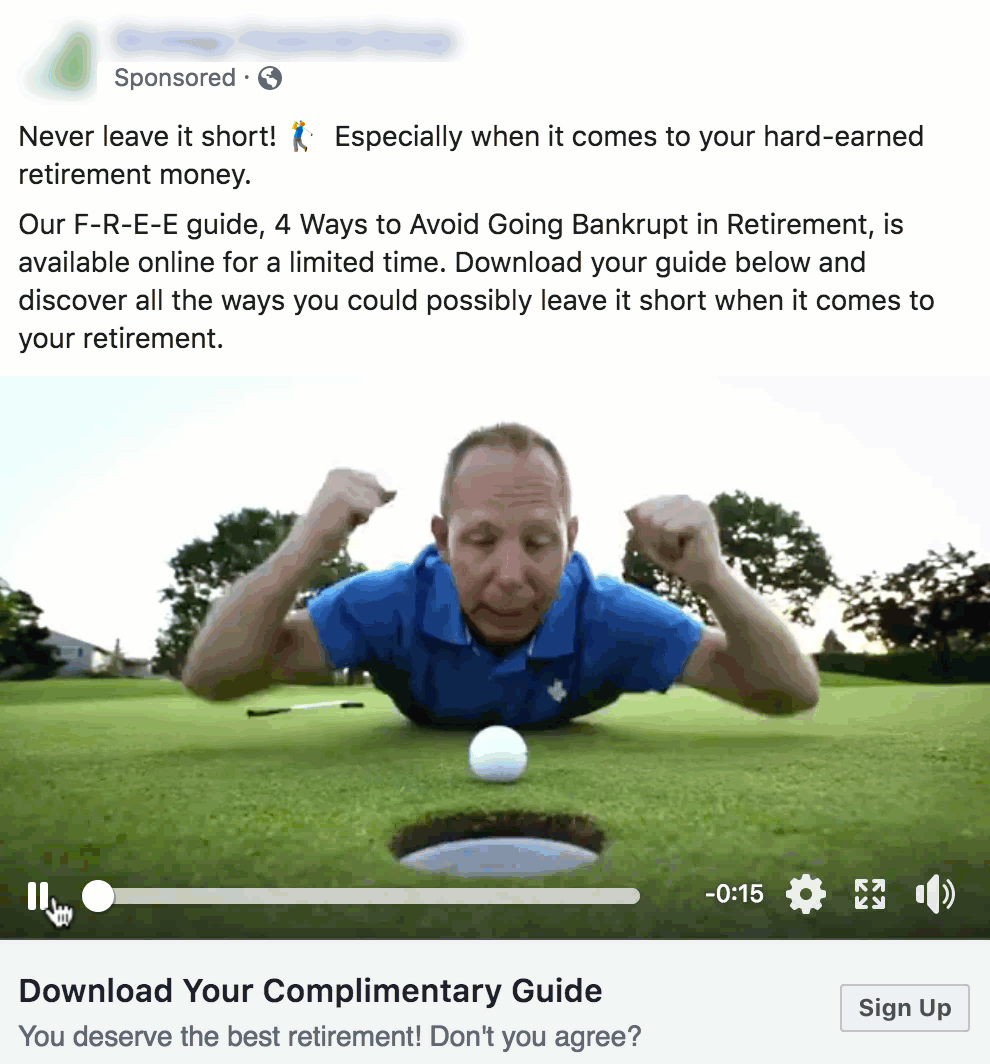“Approximately 96 percent of visitors that come to your website are not ready to buy, but they may be willing to provide contact information in exchange for valuable content.”
Let that sink in for a second. Almost all of your website visitors are not ready to do business with you.
But that doesn’t mean they won’t in the future, with a strong lead capturing and lead nurturing strategy.
What Is Lead Capturing?
A “lead” in digital marketing is someone who has given you their contact information in exchange for advice. Oftentimes, that advice comes in the form of a white paper, ebook, video, etc. There are numerous tactics for collecting contact information. Your prospect may complete a form on your website, sign-up for a newsletter, respond to your Facebook ad. Below is an example of a Facebook ad from one of our social media clients. Notice the download option that captures the prospect’s email.

Great, you have their information. Now what? We have conversations with financial advisors daily on the effort it requires to convert digital leads to clients. There are common misconceptions that these leads are eager to become clients. While there’s always a rare exception, most of your leads will take a considerable amount of nurturing.
What Is Lead Nurturing?
It’s the process of building a relationship with your lead through a series of interactions. Each interaction should help educate your lead and inch them closer and closer towards working with you. When the need arises, they immediately think of you as the go-to source.
What Tactics Can You Use for Lead Nurturing?
Have you ever filled out a lead form for Fisher Investments? Perhaps you saw their attention-grabbing Facebook ad, “Annuities Are the Devil!” and decided to download their white paper. Once they have your contact information, you’ve just flipped the switch on their impressive lead-nurturing machine.
You’ll soon get a personal phone call followed by a series of emails, physical mail and retargeting. This approach is expensive and takes precise coordination, yet it enables them to hit their prospect from multiple angles. If they don’t read email, maybe they read physical mail. If they toss snail mail, maybe they’ll take a personal call. We’re not advocating you become Fisher, but from a lead-nurturing perspective, their example is a good one.
When it comes to lead nurturing, implementing a variety of the following will help drive results.
Social media content: This should be a given. After you capture a lead, especially on social media, you should continue to post regularly and provide valuable content. You respond to their comments and make an effort to engage them in conversation. Leads should see your brand in their feed on a regular basis.
Email newsletter: This is one of our favorite lead-nurturing strategies. Think of email newsletters like a traditional newspaper. It provides free, high-value educational content on a regular basis with minimal promotion. This approach builds trust over time and trust creates clients. For those of you who receive our newsletter, it should come as no surprise that we’re fans of this approach. Our Oechsli Newsletter is one of our biggest business builders. We’ve built a giant subscriber base and consistently send great content to financial advisors (just like this).
Email sequence: This is the close cousin to the newsletter option. An email sequence is an email drip campaign sent to your prospect the moment you capture their information. While it may sound similar to a newsletter, there are some key differences. First, email sequences are typically more promotional in nature. While they provide some valuable content, they also educate your lead on who you are and how you can help them. Secondly,
they’re typically less graphical or visual in nature. A lot of times, they’re plain text with links. Lastly, they have a finite ending. When we typically build these for clients, we use eight emails spread out over three to four months.
Retargeting: Have you ever visited a website and later you’re on Facebook and see an ad with their product or service? Magic? Hardly, it’s retargeting. Retargeting helps keep your brand in front of website visitors or video watchers. It can be highly effective because it keeps you front and center with leads who are already somewhat familiar with your brand.
Direct mail: As we become more digital, some people still appreciate snail mail. Even though this approach may seem outdated, some financial advisors claim that direct mail is more alive than ever. If you go this route, do your best to ensure that your mail doesn’t look like junk; it can get tossed in a hurry. Because of the high-cost often associated with direct mail, consider reserving this nurturing technique only for leads who you deem as high quality.
Personal phone call: Not all leads will be responsive by phone, but some will. Anyone taking this approach will need to develop a common script to leverage, and timing is everything. The quicker you reach out after a conversion, the better. Remember, your outreach should be personable and not pushy. This is their most intimate interaction with your brand, so you want them walking away with a positive experience.
LinkedIn messaging: Is LinkedIn the new email? I wouldn’t go that far. However, LinkedIn’s popularity is continuing to grow and response rates are soaring. This strategy involves connecting with your lead and messaging them a sequence of helpful content. Just remember, it’s really important to keep LinkedIn messaging conversational so to add value.
While this is not an end-all list, you get the idea. Once you determine the lead-nurturing tactics you’ll use, you’ll need to develop a sequence.
Build the Machine and Let It Run.
Most of us are familiar with the “Rule of Seven,” created by Dr. Jeffrery Lant. It states that you must have at least seven interactions with a prospect within an 18-month period in order for them to remember you. Even though this rule originated before the selfie-age, its wisdom regarding multiple touchpoints holds true.
@StephenBoswell is president of The Oechsli Institute and co-author of Best Practices of Elite Advisors. @KevinANichols is the chief operating officer for The Oechsli Institute and co-author of The Indispensable LinkedIn Sales Guide for Financial Advisors.





